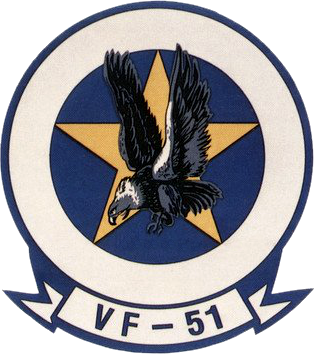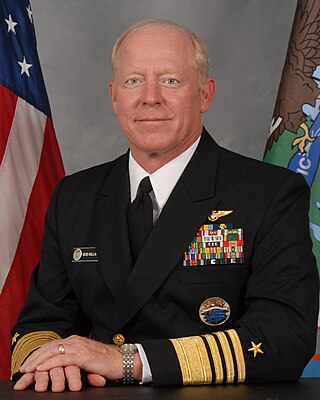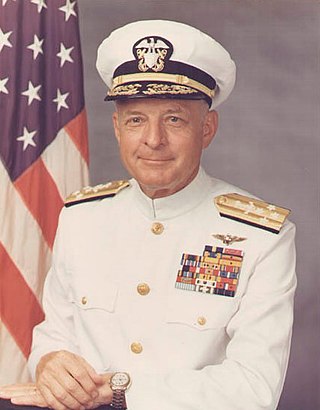
Strike Fighter Squadron 211 (VFA-211), nicknamed the "Fighting Checkmates", is an aviation unit of the United States Navy established in 1945. The squadron is based at Naval Air Station Oceana and is equipped with the Boeing F/A-18E Super Hornet.

Strike Fighter Squadron 213 (VFA-213) Blacklions is an aviation unit of the United States Navy based at Naval Air Station Oceana, Virginia. It was established in 1955 and is currently equipped with the F/A-18F Super Hornet. The squadron is assigned to Carrier Air Wing Eight and uses the radio callsign Lion.
William Douglas Houser was a United States Navy officer who later served as a telecommunications executive.

Fighter Squadron 24 (VF-24), called the Fighting Renegades was a fighter squadron of the United States Navy. Originally established as Fighter Squadron 211 in June 1955, it was redesignated VF-24 on 9 March 1959 and disestablished on 31 August 1996.

VF-51, Fighter Squadron 51 was an aviation unit of the United States Navy known as the "Screaming Eagles". It was originally established as VF-1 on February 1, 1943, redesignated as VF-5 on July 15, 1943, redesignated as VF-5A on November 15, 1946, redesignated VF-51 on August 16, 1948, and disestablished in March 1995. Until its disestablishment, VF-51 was the oldest fighter squadron in continuous service with the Pacific Fleet.

Fighter Squadron 114 (VF-114) was a fighter squadron of the United States Navy that was active from 1945 through 1993. Nicknamed the "Aardvarks", it was based out of Naval Air Station Miramar, California. The squadron flew combat missions during the Korean War and Vietnam War. VF-114 was disestablished as part of the post-Cold War drawdown of forces on April 30, 1993.

Strike Fighter Squadron 143 (VFA-143), also known as the "Pukin Dogs," is a United States Navy strike fighter squadron based at Naval Air Station Oceana, Virginia. The Pukin Dogs are an operational fleet squadron and flying the F/A-18E Super Hornet. They are currently attached to Carrier Air Wing Seven and USS George HW Bush. They are currently at their homeport of NAS Oceana. Their radio callsign is Taproom.

Strike Fighter Squadron 154 (VFA-154), also known as the "Black Knights", is a United States Navy strike fighter squadron stationed at Naval Air Station Lemoore. The Black Knights are an operational fleet squadron flying the F/A-18F Super Hornet. They are currently attached to Carrier Air Wing Eleven and deployed aboard the aircraft carrier USS Theodore Roosevelt. Their tailcode is NH and their callsign is "Knight".

Robert Frederick Willard is a retired United States Navy admiral who last served as the 22nd Commander, U.S. Pacific Command from October 19, 2009 to March 9, 2012. He previously served as Commander, U.S. Pacific Fleet from May 8, 2007, to September 25, 2009. Prior to that, he served as the 34th Vice Chief of Naval Operations from March 18, 2005, to April 2007. On March 9, 2012, Admiral Willard retired from the Navy after 39 years of service. On May 9, 2012, he was elected president and chief executive officer of the Institute of Nuclear Power Operations, succeeding retired Navy admiral James O. Ellis Jr.

Strike Fighter Squadron 94 (VFA-94), also known as the Mighty Shrikes, is a United States Navy fighter squadron stationed at Naval Air Station Lemoore. It is an operational fleet squadron currently flying the F/A-18F Super Hornet. It is attached to Carrier Air Wing 17 and based at NAS Lemoore, California. Its tail code is "NA" and its radio call sign is "Hobo".

Strike Fighter Squadron 27 (VFA-27), also known as the "Royal Maces", are a United States Navy F/A-18E Super Hornet fighter squadron stationed at Marine Corps Air Station Iwakuni. They are a part of Carrier Air Wing 5 and are attached to the aircraft carrier USS Ronald Reagan. Their tail code is NF.

Strike Fighter Squadron 105 (VFA-105) also known as the "Gunslingers" is a United States Navy strike fighter squadron based at Naval Air Station Oceana, Virginia. The "Gunslingers" are an operational fleet squadron and fly the F/A-18E Super Hornet. Their radio callsign is "Canyon" and the tail code is AC.

Strike Fighter Squadron 192 (VFA-192), also known as the "World Famous Golden Dragons", are a United States Navy F/A-18E Super Hornet fighter squadron stationed at NAS Lemoore.

Rear Admiral Richard Joseph Naughton was the superintendent of the U.S. Naval Academy from 2002 to 2003.

VF-121 of the US Navy was a former Pacific Fleet Replacement Air Group (RAG) unit. Originally established on 1 July 1946, as VF-781, it was redesignated as VF-121 on 4 February 1953 and disestablished on 30 September 1980. On 11 April 1958 it changed duty from Fleet Squadron to Fleet Replacement Squadron and was later charged with the training of Navy F-4 Phantom flight and maintenance crews.

Donald Cooke Davis was a Naval Aviator and later an admiral in the United States Navy. He was Commander of the U.S. Pacific Fleet from 1978 to 1981.

VA-52 was an Attack Squadron of the U.S. Navy. It was established as U.S. Navy Reserve Fighter Squadron VF-884 on 1 November 1949, and called to active duty on 20 July 1950. It was redesignated VF-144 on 4 February 1953, and VA-52 on 23 February 1959. The squadron was nicknamed the Bitter Birds from about 1951–1953, and the Knightriders from about 1960 onward. Its insignia evolved through several versions and variations from 1951 to the 1980s. VA-52 was decommissioned on 31 March 1995.

RVAH-13 was a Reconnaissance Attack (Heavy) Squadron of the U.S. Navy. Originally established as Heavy Attack Squadron Thirteen (VAH-13) on 3 January 1961 it was redesignated as Reconnaissance Attack (Heavy) Squadron Thirteen (RVAH-13) on 1 November 1964. The squadron was disestablished on 30 June 1976.

Fighter Squadron 111 (VF-111), also known as the Sundowners, was a fighter squadron of the United States Navy. Originally established as Attack Squadron 156 (VA-156) on 4 June 1955, it was redesignated VF-111 on 20 January 1959, the day after the original VF-111 was disestablished. The squadron was redesignated VF-26 on 1 September 1964, redesignated as VF-111 on 17 September 1964 and disestablished on 31 March 1995.
Dan Pedersen is a retired United States Navy Captain, credited as being the leading force behind the creation of the United States Navy Fighter Weapons School program known as “TOPGUN”.

















